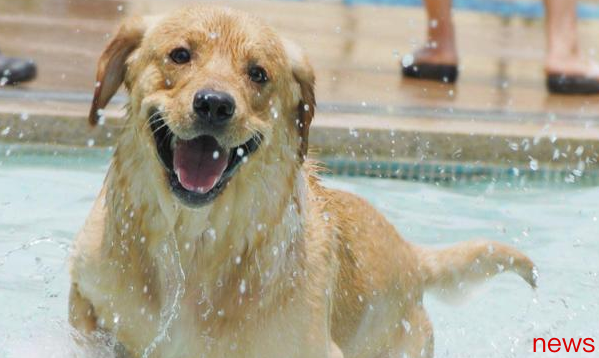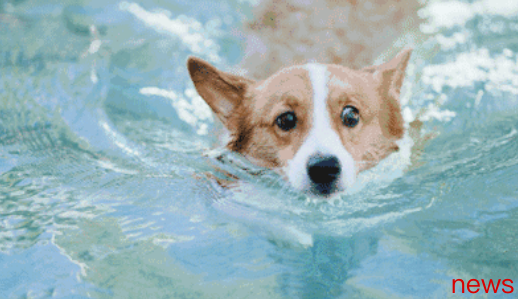Are dogs born to swim? Many people say that as long as they throw them into the water, they will start swimming by themselves without anyone teaching them. What the veterinarian Xiao Ming wants to say is that some dogs do know how to swim, but some dogs that not only can’t swim may also lead to drowning. Here are some tragedies caused by various reasons:
"My friend's Dharma Fight drowned because he drowned in the xx swimming pool. When he watched the surveillance, the dog wanted to go ashore and was pushed back into the water by the staff, which eventually led to his death..."
"The whole family went to the beach to swim, but because the golden retriever was afraid in the water, he grabbed the little girl at home and almost drowned..."
"My dog is a golden retriever. I took it to the riverside in the suburbs. I swam very well when I first got into the water. After a while, I became farther and farther away, and showed that I tried hard to get ashore. I couldn't do it when I finally caught it..."
These are all cases of drowning in living dogs, and they all believed that dogs were born to swim, so I ignored the precautions for taking them to swim, which eventually led to the tragedy.
Here I want to tell you that not every dog is a natural swimming athlete. According to the dog's body structure, their body density is slightly smaller than that of water. They can easily float themselves in the water, and then swing up and down the limbs (that is what we often call dog-planing swimming), which can ensure that their bodies do not sink into the water, but this does not mean that they can swim proficiently.
Let’s talk about which dogs are suitable for swimming, which dogs are not suitable for swimming, and five precautions for taking dogs to swim.

What are the dogs suitable for swimming?
(We are talking about dog breeds that are more suitable for swimming. For each dog, specific situations need to be analyzed. Different swimming locations, times, or different personalities will affect the actual situation of dog swimming.)
1. Golden Retrievers
For golden retrievers who master swimming skills and can swim proficiently, their dense hair helps paddling, which allows them to swim freely in the water. At the same time, golden retrievers are also hunting dogs and can also be hunted in the water.
2. Labrador Retrievers
Labradors can even engage in preying on water birds. Their bodies are soft and strong, and they can easily have good water quality.
4. VIP
VIP has been trained by people to hunt ducks before, and is also a dog with good water quality.
4, Portuguese water dogs and Spanish water dogs
These special breeds make them have excellent underwater working ability and can perform fishing, birding and other work.
It should be emphasized that for dogs suitable for swimming, even if they have swimming skills, they cannot just throw them into the water directly. Dogs still need to go through a period of training before they can master swimming.
Some dogs cannot swim in the water for a long time due to physical condition, nervousness, timidity and other personality reasons.

What are the dogs that are not suitable for swimming?
Compared with the medium and large dogs above, most of the dogs that are not suitable for swimming are small dogs. The main characteristics are short nose and flat face, which is easy to choke in water; short limbs and cannot flexibly paddle; high bone density, body heavier than head, and cannot guarantee that the head will surface for a long time, etc.
For dogs with these characteristics, the owner should try not to let them swim, so as not to cause harm to the dog.
1. Dogs with short noses and flat faces such as pugs, bulldogs, boxers
are prone to choking on water. In the water, they will try their best to stick their heads out of the water surface, and the back end of their bodies will sink, so they cannot swim in the water for a long time.
2, Corgi, sausage
Their short legs need to paddle at high frequency in the water, which will consume a lot of their physical strength and will not be able to move in the water for a long time.
3. The hair of Shih Tzu, Maltese, Chow Chow
Shih Tzu, Chow Chow may be too long and may be wet and heavy after entering the water. It will not only cover the face and block their view, but may even cause difficulty in breathing. This type of dog is also more afraid of cold and will be more likely to cause arthritis, rheumatism and other diseases.
4. Staffordshire Bulldogs
Their muscles are well developed and have high bone density, and their bodies will easily sink after going into the water, so they are not suitable for swimming.
5. Basset dogs have big ears, and once water enters, it is easy to breed bacteria. At the same time, the large ears also add a lot of resistance to their swimming. In addition to these dogs, there are also many small and long-haired dogs that are not suitable for long-term swimming.
In fact, swimming is very helpful to their bones and can also exercise their physical fitness. Dogs who swim regularly are more conducive to their physical and mental health.
For their dogs, if they are not suitable for swimming but are not afraid of water, they can wear swimming rings for them and play interactively in the water. Even if they have swimming skills, they will be afraid of nervousness in the water, so they try not to take them to play in the water.
Precautions for swimming with dogs
1. Preparations before swimming
Remember not to throw the dog into the water directly when he is unprepared. This will be a huge harm to the dog's body and mind. The dog is also prone to catch a cold and get sick after getting ashore.
Before taking a dog to swim, the owner should prepare a dry towel, a hair dryer, a leash, a water cup, a dog shower gel, a life jacket (or a lifebuoy), a cotton swab, etc. in advance.
Before the dog goes into the water, you should take the dog for ten minutes of warm-up exercise to warm the dog's body.
2. First adapt to the
in shallow water zone, dogs should swim step by step. The owner first plays with the dog in the shallow water area. When necessary, bring the dog's small toys to let the dog relax and adapt to the water, and then enter the deep water area.
If the dog cannot adapt in shallow water and is very repulsive, it is also convenient for the owner to take them out of the swimming area.
3. Observe the dog's physical reaction to control swimming time
If the dog's swimming speed is significantly slower, you can let them land at this time and record the time so that you can take them to train next time.
If the dog is restless, constantly sinking and floating, cramping and weak, you should stop swimming immediately and take them away.
4. Avoid swimming in the wild
We are not familiar with the rivers and waters in the wild. There may be obstacles such as aquatic plants to prevent dogs from advancing. Some undercurrents and vortexes are a great life threat to dogs and humans. Try to stay away from these dangerous areas as much as possible.
5. Care after swimming
After the dog swims, take the dog to take a shower in time, clean it with a shower gel, then immediately blow dry the hair, clean the ears with a cotton swab, and replenish them with moisture and energy in time.
The above are five precautions for dog swimming. Mastering these can effectively prevent dog drowning. Many people experiment with dogs being born to swim. No matter where they are, they suddenly pick up the dog and throw it into the water, and then enjoy it and severely condemn such behavior. This is an indifference to the life of dogs.
Dear poop shovelers, please take your dog to swim according to the actual situation of their dogs. Dogs that are not suitable for swimming must not force them.